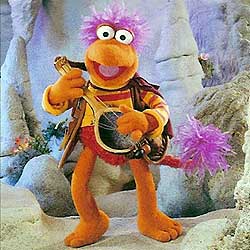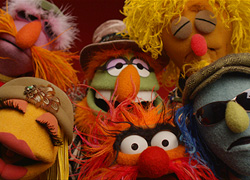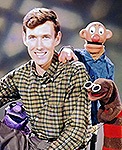-
 Welcome to the Muppet Central Forum!
Welcome to the Muppet Central Forum!
You are viewing our forum as a guest. Join our free community to post topics and start private conversations. Please contact us if you need help. -
 Back to the Rock Season 2
Back to the Rock Season 2
Fraggle Rock Back to the Rock Season 2 has premiered on AppleTV+. Watch the anticipated new season and let us know your thoughts. -
 Sesame Street Season 54
Sesame Street Season 54
Sesame Street Season 54 has premiered on Max with new episodes each Thursday. Watch and let us know your thoughts. -
 The Muppets Mayhem premieres
The Muppets Mayhem premieres
The series debut of the year is here! Let us know your thoughts and reviews of The Muppets Mayhem now streaming on Disney+. -
 Bear arrives on Disney+
Bear arrives on Disney+
The beloved series has been off the air for the past 15 years. Now all four seasons are finally available for a whole new generation. -
 Sam and Friends Book
Sam and Friends Book
Read our review of the long-awaited book, "Sam and Friends - The Story of Jim Henson's First Television Show" by Muppet Historian Craig Shemin.
UK DVDs
- Thread starter behemoth
- Start date
anathema
Well-Known Member
- Joined
- Jun 20, 2002
- Messages
- 1,697
- Reaction score
- 48
There are currently two discs available. The first has the Elton John and Mark Hamill episodes on it, plus the 'Very Best of (Vol 1)' compilation that was released on VHS a few years ago, and the documentary 'Of Muppets And Men'. The second disc contains the Sylvester Stallone and Roger Moore shows, the 'Very Best of (Vol 2)' compilation and some of the 'Muppet Fairy Tales' (I don't recall which).
All episodes are uncut (apart from the final shot of Zoot at the end of the credits).
You should be able to get both discs from places like Amazon.co.uk; however, they will not play in the vast majority of US DVD players. If you're seriously interested, you'll need a player which can handle Region 2 PAL discs.
All episodes are uncut (apart from the final shot of Zoot at the end of the credits).
You should be able to get both discs from places like Amazon.co.uk; however, they will not play in the vast majority of US DVD players. If you're seriously interested, you'll need a player which can handle Region 2 PAL discs.
Boober_Gorg
Well-Known Member
- Joined
- Oct 16, 2002
- Messages
- 1,376
- Reaction score
- 14
I have a question: why do R2 DVDs look like VCDs instead of videos (or region 1 DVDs)? Conversion loss or something?
Luke
Well-Known Member
- Joined
- Apr 13, 2002
- Messages
- 7,405
- Reaction score
- 98
R2 UK DVD's (PAL) should actually look and be of far higher quality than R1 USA (NTSC) - we have a better quality framerate. Sometimes they use up more of the space on our discs with Euro subtitles and language tracks though which might cause some loss of quality. Maybe Boober your DVD player is 'playing up' when trying to handle the PAL/NTSC conversion ?
anathema
Well-Known Member
- Joined
- Jun 20, 2002
- Messages
- 1,697
- Reaction score
- 48
To clarify this: we don't have a 'better quality framerate', we just use a different framerate over here. The Muppet Show was made on UK standard equipment, so it will always look better on UK DVDs than US ones, since no conversion is involved. (There is no good way to convert between the framerates, just a choice of compromises). A TV show made on US equipment will always look better on a US DVD for exactly the same reason.
When you say they look like VCDs, are you referring to the motion, or the resolution of the picture?
When you say they look like VCDs, are you referring to the motion, or the resolution of the picture?
anathema
Well-Known Member
- Joined
- Jun 20, 2002
- Messages
- 1,697
- Reaction score
- 48
Actually, no  The more frames per second you run at, the smoother the illusion of motion.
The more frames per second you run at, the smoother the illusion of motion.
The minimum number needed to create this illusion is about 16, and this is what early film cameras ran at. However, it was quickly discovered that this wasn't enough to cope with fast motion (eg in the cowboy movies of the day), so it was raised to the current rate of 24. However, while this is enough to cover motion, the level of flicker when the film is projected is unacceptable, so each frame is actually shown twice by opening and closing the shutter at a rate of 48Hz.
UK television runs at 25fps. The rate was chosen because it allowed the video image to be synchronised to the mains frequency of 50Hz, and it was close enough to the accepted film rate to make airing a movie fairly straightforward. US television runs at 30fps as the mains frequency there is 60Hz. Putting film onto US video is more complex
The above paragraph is not entirely true Video frames actually consist of a pair of fields, captured at a rate of 50 (or 60) per second. The two images represent unique moments in time, and are interlaced together - the first field contains lines 1, 3, 5, 7... and the second contains lines 2, 4, 6, 8... The net effect is to give a picture update rate of 50 or 60, thus reducing the flicker without having to capture and transmit 50 complete frames per second, which the technology of the day couldn't handle. (US colour video actually runs at 59.94 fields per second, but that's another story
Video frames actually consist of a pair of fields, captured at a rate of 50 (or 60) per second. The two images represent unique moments in time, and are interlaced together - the first field contains lines 1, 3, 5, 7... and the second contains lines 2, 4, 6, 8... The net effect is to give a picture update rate of 50 or 60, thus reducing the flicker without having to capture and transmit 50 complete frames per second, which the technology of the day couldn't handle. (US colour video actually runs at 59.94 fields per second, but that's another story 
The problem involved in converting between UK and US video should now be apparent: the source fields were captured at slightly different points in time, and will only line up with the required destination field times a few times per second. There are three basic approaches to achieving the conversion:
You can repeat or omit fields as required. This is simple, cheap and has the significant drawback of producing juddery motion (akin to the effects produced when film is transferred to US video standards).
You can create the new fields required by blending the existing ones together, the proportions of the blend being determined by the proximity of each original field to the desired output time. This is also simple and cheap, and more-or-less eliminates the judder, albeit at the expense of a slightly blurry image, particularly where there's motion.
Finally, the new fields required can be interpolated by doing motion-estimation. This is complex and expensive, but if done well, it produces by far the best results.
All of these involve a compromise; there is no way to achieve perfect results. Hence, video purists like myself prefer to obtain and view video-originated programmes in their original format.
Most US DVD players which can handle PAL discs do so by converting the video data in this fashion, probably by using the second method described above. Really cheap players may use the first method. I'm not aware of any that currently use the third method, due to its cost. When I do standards-conversions, I use the second method, as I haven't the software or hardware to do number 3, and I find the results to be about as acceptable as any US picture I've seen.
 The more frames per second you run at, the smoother the illusion of motion.
The more frames per second you run at, the smoother the illusion of motion.The minimum number needed to create this illusion is about 16, and this is what early film cameras ran at. However, it was quickly discovered that this wasn't enough to cope with fast motion (eg in the cowboy movies of the day), so it was raised to the current rate of 24. However, while this is enough to cover motion, the level of flicker when the film is projected is unacceptable, so each frame is actually shown twice by opening and closing the shutter at a rate of 48Hz.
UK television runs at 25fps. The rate was chosen because it allowed the video image to be synchronised to the mains frequency of 50Hz, and it was close enough to the accepted film rate to make airing a movie fairly straightforward. US television runs at 30fps as the mains frequency there is 60Hz. Putting film onto US video is more complex

The above paragraph is not entirely true
 Video frames actually consist of a pair of fields, captured at a rate of 50 (or 60) per second. The two images represent unique moments in time, and are interlaced together - the first field contains lines 1, 3, 5, 7... and the second contains lines 2, 4, 6, 8... The net effect is to give a picture update rate of 50 or 60, thus reducing the flicker without having to capture and transmit 50 complete frames per second, which the technology of the day couldn't handle. (US colour video actually runs at 59.94 fields per second, but that's another story
Video frames actually consist of a pair of fields, captured at a rate of 50 (or 60) per second. The two images represent unique moments in time, and are interlaced together - the first field contains lines 1, 3, 5, 7... and the second contains lines 2, 4, 6, 8... The net effect is to give a picture update rate of 50 or 60, thus reducing the flicker without having to capture and transmit 50 complete frames per second, which the technology of the day couldn't handle. (US colour video actually runs at 59.94 fields per second, but that's another story 
The problem involved in converting between UK and US video should now be apparent: the source fields were captured at slightly different points in time, and will only line up with the required destination field times a few times per second. There are three basic approaches to achieving the conversion:
You can repeat or omit fields as required. This is simple, cheap and has the significant drawback of producing juddery motion (akin to the effects produced when film is transferred to US video standards).
You can create the new fields required by blending the existing ones together, the proportions of the blend being determined by the proximity of each original field to the desired output time. This is also simple and cheap, and more-or-less eliminates the judder, albeit at the expense of a slightly blurry image, particularly where there's motion.
Finally, the new fields required can be interpolated by doing motion-estimation. This is complex and expensive, but if done well, it produces by far the best results.
All of these involve a compromise; there is no way to achieve perfect results. Hence, video purists like myself prefer to obtain and view video-originated programmes in their original format.
Most US DVD players which can handle PAL discs do so by converting the video data in this fashion, probably by using the second method described above. Really cheap players may use the first method. I'm not aware of any that currently use the third method, due to its cost. When I do standards-conversions, I use the second method, as I haven't the software or hardware to do number 3, and I find the results to be about as acceptable as any US picture I've seen.
